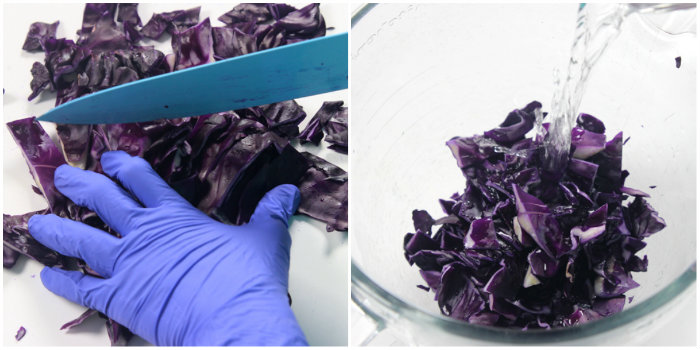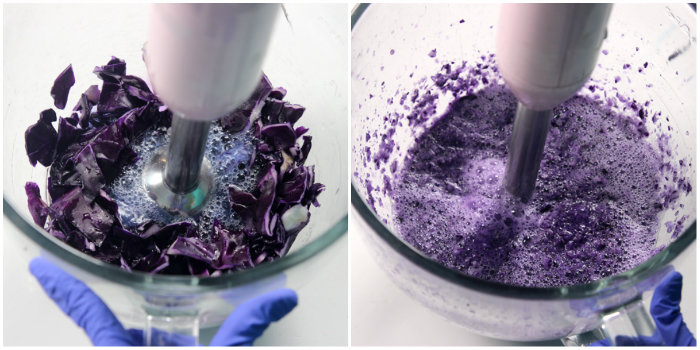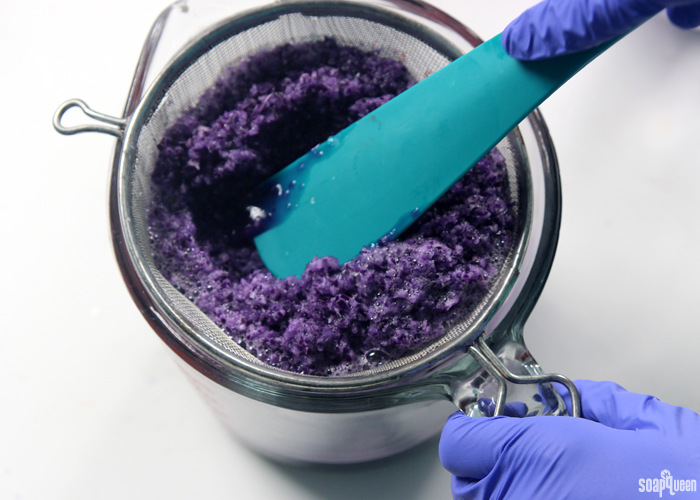July 20, 2019 | F.Lab
It's been a while since we've posted here. Our DIYbio hardware updates are usually posted on the Applied Technology Lab blog here and all the files and build instructions are in ProgressTH's Thingiverse DIYbio collection here.
Since our last post which was about version 2 of our centrifuge, we've developed a larger orbital shaker, a larger and more powerful magnetic stirrer, and version 3 of our centrifuge.
Maybe the coolest thing is that many of the ideas behind our updates come from people on Thingiverse making and modifying our designs. The use of DC motors and cheap motor speed controllers was something we didn't think about (because we didn't have them on hand) but was such a great idea we ordered and incorporated them into newer designs.
20 July 2019
23 September 2018
Protocol: Red Cabbage pH Testing
September 23, 2018 | F.Lab
2. Steps




Testing pH is useful for a wide variety of reasons, from testing homemade soap to make sure it is balanced and not lye heavy, to optimizing hydroponics, to satisfying simple curiosity. Yet pH testing strips or meters might not be readily available.
One thing that usually is, however, is red cabbage. This simple protocol allows you to take red cabbage and use it to do basic and reliable pH testing.
The protocol produces red cabbage juice, which can be used if kept refrigerated for at least 2-3 days afterward. Make sure you are using distilled water if you mix samples with the red cabbage juice, otherwise the pH of your water might interfere with the results.
1. Materials
Red Cabbage (1 head)
Blender (1)
Blender (1)
Measuring Cup (1 cup)
Mixing Bowl (1)
Dropper/Straw (1, optional)
Mixing Bowl (1)
Dropper/Straw (1, optional)
Distilled water (1 cup)
2. Steps
1. Chop up 3-4 leaves of red cabbage;
2. Pour 1 cup of distilled water into the chopped cabbage;
3. Blend the mixture;
4. Strain the mixture and save the liquid and;
5. Apply one drop of liquid on the test subject.
3. pH Results
The liquid will appear purple before changing.
24 June 2018
New 3D Printed DIYbio Equipment
June 24, 2018 | F.Lab Although we haven't updated this particular website in a while, we have been working on lots of DIYbio projects. F.Lab's various members have been busy with related projects in agriculture and education.
We've had a few major updates on DIYbio equipment too. This includes:
And we are working on several more improvements:
F.Lab is Thailand's first DIYbio lab. Check us out on Facebook here.
We've had a few major updates on DIYbio equipment too. This includes:
Centrifuge V2.0: This new design incorporates a DC motor, eliminating the need for an Arduino and electronic speed controller (ESC) for the original design's drone motor. The new design uses a simple rocker switch to turn it on and off. It also has a micro-switch to cut power when the lid is opened. The lid has a piece of acrylic included to allow users to observe the centrifuge when in use. The files and instructions can be found here on Thingiverse.
Orbital Shaker V1.0: This is our first attempt at an orbital shaker and is the prototype we will be using to develop a much larger version, as well as other motion-controlled bioreactor designs. The shaker uses a stepper motor and an Arduino with speed controlled via a simple potentiometer. All the files and instructions (including videos) can be found on Thingiverse here.
Magnetic Stirrer V1.0 Update: Our original magnetic stirrer was based on a simple hack developed for a workshop to show people how easy it is to improvise lab equipment. We added some extra magnets to the fan and designed 3D printed stir bars to improve the stirring against drastically. The files can be found here on Thingiverse.
And we are working on several more improvements:
Orbital Shaker V2.0: This will be a larger version of our original orbital shaker design. It will include adjustable bars to secure containers being stirred. It will also include the ability to add in a heated bed (See: Heating Module below). The coupler used to connect the motion control system to the stepper motor has also been improved and strengthened.
Centrifuge V2.1: We've had some feedback regarding our centrifuge design. DC motors come in many sizes and shapes so we are going to update the design to include a removable bracket to allow people to design and implement their own brackets for whatever motors they have on hand.
Magnetic Stirrer V2.0: This will be a much larger and more capable stirrer. It will be made with several applications in mind including the use of the heating module described below and to hold heavier vessels such as 6 liter bottles we use for hydroponic solution mixing.
Timing Module: While it would be possible to design each piece of equipment to include a programmable timer, the entire point of this project is to keep costs down. So we're making a single module with multiple channels to hook up and program timing functions for multiple pieces of equipment at once.
Heating Module: Justl ike with the timing module, we could create a heating module for the shaker, the stirrer, and upcoming rockers and reactors, but it would be easier to have a single module with multiple channels and heating beds. This means we need only one large power supply and one centralized programmer.If you have any questions or would like to see more information about all of these projects, check out ProgressTH.org's DIYbio section. ProgessTH is developing the hardware for F.Lab. You can also check out the new Applied Technology Lab blog ProgressTH is using to document the technical development of their projects.
F.Lab is Thailand's first DIYbio lab. Check us out on Facebook here.
07 May 2016
A 3D Printed Electrophoresis System
May 7, 2016 | F.Lab With the centrifuge working well enough to extract DNA, and the stirrer waiting for a practical application to test it (stirring agar solution?), we've decided to move on to an electrophoresis system next to help visualize our DNA samples.
We're building a very compact, simple system to start with and learn from. From this, we can move on to bigger and better systems.
We're building a very compact, simple system to start with and learn from. From this, we can move on to bigger and better systems.
15 January 2016
F.Lab 3D Printed Lab Equipment Goes to Real Lab
January 15, 2016 | F.Lab This week we got an opportunity to take part in a molecular biology workshop at King Mongkut's University of Technology Thonburi (KMUTT). You can read more about the workshop itself here. We also thought we'd bring along some of the lab equipment we developed, including 3D printed tube racks (some of which we gave to KMUTT as a token of appreciation) and our centrifuge.
We even got to use the centrifuge briefly for one part of the protocol, along side other industry-made centrifuges so we could contrast and compare.
For a real small group of DIYbiologists, our lab equipment would probably work great. For large groups participating in a workshop, probably not so great. So perhaps in the next iteration of our centrifuge, or perhaps a lower-cost workshop version, we will make it easier to use.
We even got to use the centrifuge briefly for one part of the protocol, along side other industry-made centrifuges so we could contrast and compare.
For a real small group of DIYbiologists, our lab equipment would probably work great. For large groups participating in a workshop, probably not so great. So perhaps in the next iteration of our centrifuge, or perhaps a lower-cost workshop version, we will make it easier to use.
Workshop Opens Eyes to the Complexity/Simplicity of Biotechnology
January 15, 2016 | ProgressTH Whether you realize it or not, biology itself is a sort of technology. It is a set of tools that have been naturally developed to allow organisms, including us, to survive in a variety of environments. Just like a high-tech solar panel provides our homes and places of work with electricity, our biology provides our bodies with energy, as well as defenses against a long list of threats big and small, and the ability to move through and appreciate the planet we live on.
Human beings have, over time, learned to use the tools of biology in a wide range of novel ways. Aspects of certain bacteria allow us to cut, copy, paste, amplify, and analyze DNA. This allows us to understand life on a molecular level, as well as re-engineer it in a variety of ways to serve our various needs.
All of this is done in the molecular biology lab.
 |
| Students learn how to load and program a thermocycler which heats and cools DNA, combining them with primers, to help isolate sequences of interest for further examination. |
All of this is done in the molecular biology lab.
18 December 2015
What is Do-It-Yourself Biology?
December 18, 2015 | ProgressTH Talk of DNA and biotechnology generally conjures up images of movie monsters or talk of large agricultural companies that use genetic engineering to modify organisms (GMOs). And for the longest time to ordinary people, biotechnology really was something they could only see in fiction or in practice in the hands of large, well-funded corporations and institutions.
But like computers, which also started out as an inaccessible curiosity to regular people, biotechnology is finally making its way into the hands of a much larger community.
Enter DIYbio
That's where the DIYbio movement comes in. DIYbio is the local use of the tools and techniques of biotechnology by regular people who may not be trained scientists, but have an interest in biotechnology nonetheless.
But like computers, which also started out as an inaccessible curiosity to regular people, biotechnology is finally making its way into the hands of a much larger community.
Enter DIYbio
That's where the DIYbio movement comes in. DIYbio is the local use of the tools and techniques of biotechnology by regular people who may not be trained scientists, but have an interest in biotechnology nonetheless.
Subscribe to:
Posts (Atom)






